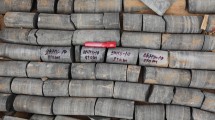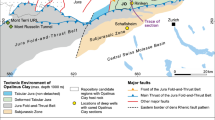Abstract
Tamusu area in Inner Mongolia is a candidate site for the first clay rock repository in China. Comprehensive analyses conducted on stratigraphic characteristics, mineralogy, structural geology, and three-dimensional geological modeling in the Tamusu area showed that: the thickness of clay rock is more than 200 m with burial depth ranging from 200 to 800 m, which is mainly composed of zeolite, dolomite, and illite. Fractures are not well developed and the tectonic environment is stable. Additionally, the terrain and landform are relatively flat and desolate. These findings suggest that the Tamusu area presents favorable geological conditions for the construction and operation of a high-level radioactive waste repository.




















Similar content being viewed by others
Data availability
All data, models, and code generated or used during the study appear in the submitted article.
References
Laurence SC (1997) Site selection and characterization processes for deep geological disposal of high-level nuclear waste. Albuquerque Sandia National Laboratories
Pan Z, Qian Q (2009) Research on geological disposal strategy of high level radioactive waste. Atomic Energy Press, Beijing, pp 15–17
IAEA (1997) Experience in selection and characterization of sites for geological disposal of radioactive waste. Technical Report No. 991, Austria
IAEA (2003) Scientific and technical basis for the geological disposal of radioactive waste. Technical Report Series No. 413
IAEA (2006) IAEA safety standards series no. SF-1, fundamental safety principles, safety fundamentals. IAEA, Vienna
Dossier A (2005) Argile-architecture and management of a geological repository. ANDRA, Paris
Liu X, Liu P, Wang C et al (2010) Preliminary sitting of clay formations for HLW geological disposal repository in China. In: Professional Committee of Nuclear Safety and Radiation Environmental Safety of Chinese Society of Environmental Sciences. Proceedings of the 3rd symposium on underground waste disposal, p 11
Che S, Liu X, Liu P (2011) Research of claystone in Longdong area Gansu province. J East China Univ Technol (Nat Sci Ed) 34(02):111–116
Ding H, Liupinghui (2015) Geological characteristics of argilaceous rocks in Nanbaxian area of northwest Qaidam basin. Energy Res Manag 2015(02):87–92. https://doi.org/10.16056/j.1005-7676.2015.02.021
Zhao S, Li H, Cui Z et al (2016) Investigation on social and economic conditions of preselected area in Longdong Region for HLW geological disposal repository of clay formations. Environ Sci Manag 41(10):12–16
Tang Y, Wen Z, Zhang C et al (2007) Geochemical characteristics and origin of oil sand of Tian 2 Well, Tiancao Sag. Bull Geol Sci Technol 2007(04):47–52
Li X (2010) Sedimentary facies analysis of the upper part of the Bayingobi formation in the Tamusu area of the Bayingobi basin. J Henan Polytech Univ (Nat Sci) 29(S1):177–180. https://doi.org/10.16186/j.cnki.1673-9787,2010.s1.016
Liu X, Liu P (2012) Research on the basic characteristics of clay rock in Tamusu area of Bayingobi Basina. In: Professional Committee of Nuclear Safety and Radiation Environmental Safety of Chinese Society of Environmental Sciences. Proceedings of the 3rd symposium on underground waste disposal, p 9
Guan W, Liu X, Liu P (2014) Study on the geological characteristics of claystone in Tamusu area of Bayingebi Basin. World Nucl Geosci 31(02):95–102
Zhang Y (2016) Study on clay formation of Upper Bayingebi formation in Tamusu candidate area-high-level radioactive waste disposal repository. East China University of Technology, Nanchang
Wang F, Hou S, Zhang L et al (2018) Study on the characteristics of water-rock interaction and its relation to uranium mineralization in Tamusu Uranium Deposit, Southern Bayin Gobi asin. Geol Rev 64(03):633–646. https://doi.org/10.16509/j.georeview.2018.03.009
Peng Y, Wang Q, Dai M et al (2018) Ore body spatial distribution characteristics of TMS uranium deposit and prospecting prediction in Bayingebi basin. World Nucl Geosci 35(03):131–136
Wei S, Zhang H, Chenqilin (2006) Petroleum geological characteristics and exploration prospects of Yingen-Ejina Banner Basin. Petroleum Industry Press, Beijing
Lu J, Chen G, Wei X et al (2011) Post-sedimentary tectonic evolution, cap rock condition and hydrocarbon information of Carboniferous-Permian in Ejin Banner and its vicinities, western Inner Mongolia: a study of Carboniferous-Permian petroleum geological conditions. Geol Bull China 30(6):838–849
Huang H (2013) Tectonic framework and regional evolution characteristics of the upper Palaeozoic in Yin-E basin a case study in Ju Yanhai depression. Yangtze University, Jingzhou
Long Y (2014) Research on crustal stability of Xinchang and Jiji tank preselected sites for high-level radioactive waste repository. Beijing Research institute of Uranium Geology, Beijing
Han W (2017) Study of sedimentary-tectonic evolution since late paleozoic and its impacts on oil and gas geological conditions of Yin-E basin. Northwest University, Xi’an
Wu R, Zhou W, Liu P et al (2008) Analysis of metallogenic condition and prospecting potential of sandstone type uranium deposit in Tamusu district of Bayinggebi basin. Uranium Geol 24(1):24–31
Zhang D, Fu G, Qin E et al (2002) Jurassic palaeoclimate, Palaeovegetation and palaeoenvironment in the Tuha basin in XinJiang. Geoscience 2002(02):147–152
Wang T (1993) Late Paleozoic extension and Tectono-Magmatic evolution in the sino-mongolia border region in the northern part of Alxa. Geol Bull China 1993(04):317–327
Chen Q, Wei P, Yang Z (2006) Tectonic evolution and petroleum prospection in the Yin’gen-Ejina Basin. Pet Geol Exp 2006(04):311–315
Li Y (2006) The application of the seismic coherence technique to the interpretation of faults and sedimentary facies in the Shengli Oil Field. Sediment Geol Tethyan Geol 2006(03):67–71
Zhang C, Nie F, Hou S et al (2015) Ore-controlling factors and metallogenic model of Tamusu sandstone type uranium deposit in Bayingobi Basin, Inner Mongolia. Bull Geol Sci Technol 34(01):140–147
Liu B, Zhao C, Ying G et al (2008) The Characteristics of the Laoyachen Fault in Zhenzhou receaaled by shallow seismic date of P wave end S wave. Seismol Geol 2008(02):505–515
Wang Y, Meng G, Chai C et al (2015) The accurate location methods for buried active fault exploration: an exploration of Luhuatai Faults in Yinchuan graben. Seismol Geol 37(01):256–268
Rao Z (2018) Tectonic activity of Tamusu candidate area in Alxa Youqi, Inner Mongolia: a case study of the Tamusu fault. East China University of Technology, Nanchang
Wang L, Li H, Xu G et al (2004) Shallow seismic exploration report in Tamusu area, Alxa Right Banner, Inner Mongolia. Nuclear Industry Aerial Survey and Remote Sensing Center
Liu B, Wei B, Li Y et al (2014) Shallow seismic exploration in southwest Tamusu area of Alxa Right Banner, Inner Mongolia. Center Airborne Survey and Remote Sensing Center of Nuclear Industry
Huo L, Zhang J, Zhen L et al (2014) Fault interpretation with multiple attributes in coalbed methane interpretation. Oil Geophys Prospect 49(S1):221–227+10. https://doi.org/10.13810/j.cnki.issn.1000-7210.2014.s1.041.
Wu Q, Xu H (2004) Research on 3D geological modeling and visualization method. Sci Sin (Terrae) 2004(01):54–60
Xu W (2019) Applied research of comprehensive geophysical and three dimensional geological modeling in site evaluation of geological disposal repository of high-level radioactive waste. East China University of Technology, Nanchang
Rao Z (2021) Preliminary adaptability assessment on Tamusu Mudstone candidate sector for high-level radioactive waste geological disposal repository. East China University of Technology, Nanchang. https://doi.org/10.27145/d.cnki.ghddc.2021.000002
Acknowledgements
We would like to express sincere thanks to Dr. Shuiwei Zhao from China Institute for Radiation Protection for his helpful discussion on criterion analysis. Prof. Miles Silbeman from University of Texas at El Paso is highly acknowledged for his help on grammar correction and professional comments that helps improving this paper to a higher level. This work was funded by the National Defense science, Technology and Industry Bureau project (NO. [2014]1587), Independent Fund Projects from the State Key Laboratory of Nuclear Resources and Environment (No. Z1904), and Special funds for local science and technology development guided by the central government (No. 2018ZDB40001), and Joint Innovation Fund of China Uranium Co., Ltd. - State Key Laboratory of Nuclear Resources and Environment, East China University of Technology (2022NRE-LH-01) and National Natural Science Foundation of China (42302044).
Author information
Authors and Affiliations
Corresponding author
Ethics declarations
Conflict of interest
The authors declare no conflict interest.
Additional information
Publisher's Note
Springer Nature remains neutral with regard to jurisdictional claims in published maps and institutional affiliations.
Rights and permissions
Springer Nature or its licensor (e.g. a society or other partner) holds exclusive rights to this article under a publishing agreement with the author(s) or other rightsholder(s); author self-archiving of the accepted manuscript version of this article is solely governed by the terms of such publishing agreement and applicable law.
About this article
Cite this article
Gao, H., Li, G., Liu, X. et al. Geology of the Tamusu clay site for high level waste. J Radioanal Nucl Chem 333, 495–518 (2024). https://doi.org/10.1007/s10967-023-09228-1
Received:
Accepted:
Published:
Issue Date:
DOI: https://doi.org/10.1007/s10967-023-09228-1




